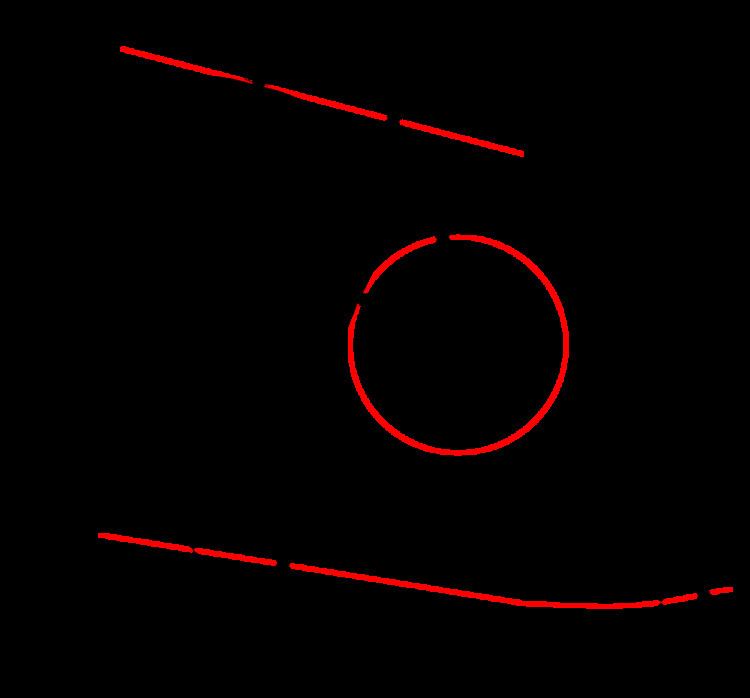 | ||
In mathematics, a Möbius plane (named after August Ferdinand Möbius) is one of the Benz planes: Möbius plane, Laguerre plane and Minkowski plane. The classical example is based on the geometry of lines and circles in the real affine plane.
Contents
- Relation to affine planes
- Classical real Mbius plane
- Axioms of a Mbius plane
- Miquelian Mbius planes
- Finite Mbius planes and block designs
- References
A second name for Möbius plane is inversive plane. It is due to the existence of inversions in the classical Möbius plane. An inversion is an involutory mapping which leaves the points of a circle or line fixed (see below).
Relation to affine planes
Affine planes are systems of points and lines that satisfy, amongst others, the property that two points determine exactly one line. This concept can be generalized to systems of points and circles, with each circle being determined by three non-collinear points. However, three collinear points determine a line, not a circle. This drawback can be removed by adding a point at infinity to every line. If we call both circles and such completed lines cycles, we get an incidence structure in which every three points determine exactly one cycle.
In an affine plane the parallel relation between lines is essential. In the geometry of cycles, this relation is generalized to the touching relation. Two cycles touch each other if they have just one point in common. This is true for two tangent circles or a line that is tangent to a circle. Two completed lines touch if they have only the point at infinity in common, so they are parallel. The touching relation has the property
These properties essentially define an axiomatic Möbius plane. But the classical Möbius plane is not the only geometrical structure that satisfies the properties of an axiomatic Möbius plane. A simple further example of a Möbius plane can be achieved if one replaces the real numbers by rational numbers. The usage of complex numbers (instead of the real numbers) does not lead to a Möbius plane, because in the complex affine plane the curve
Classical real Möbius plane
We start from the real affine plane
The geometry of lines and circles of the euclidean plane can be homogenized (similar to the projective completion of an affine plane) by embedding it into the incidence structure
with
Within the new structure the completed lines play no special role anymore. Obviously
complex numbers.
(
The advantage of this description is, that one checks easily that the following permutations of
Considering
Similar to the space model of a desarguesian projective plane there exists a space model for the geometry
Axioms of a Möbius plane
The incidental behavior of the classical real Möbius plane gives reason to the following definition of an axiomatic Möbius plane.
An incidence structure
Four points
One should not expect that the axioms above define the classical real Möbius plane. There are a lot of examples of axiomatic Möbius planes which are different from the classical one (see below). Similar to the minimal model of an affine plane one find the minimal model of a Möbius plane. It consists of
The connection between the classical Möbius plane and the real affine plane can be found in a similar way between the minimal model of a Möbius plane and the minimal model of an affine plane. This strong connection is typical for Möbius planes and affine planes (see below).
For a Möbius plane
For the classical model the residue
Theorem: Any residue of a Möbius plane is an affine plane.
This theorem allows to use the plenty results on affine planes for investigations on Möbius planes and gives rise to an equivalent definition of a Möbius plane:
Theorem: An incidence structure
For finite Möbius planes, i.e.
This gives reason for the following definition:
For a finite Möbius plane
From combinatorics we get
Miquelian Möbius planes
Looking for further examples of Möbius planes it seems promising to generalize the classical construction starting with a quadratic form
Theorem (Miquel): For the Möbius plane
If for any 8 points
The converse is true, too.
Theorem (Chen): Only a Möbius plane
Because of the last Theorem a Möbius plane
Remark: The minimal model of a Möbius plane is miquelian. It is isomorphic to the Möbius plane
Remark: If we choose
Remark: A stereographic projection shows:
Remark: A proof of Miquel's theorem for the classical (real) case can be found here. It is elementary and based on the theorem of an inscribed angle.
Remark: There are many Möbius planes which are not miquelian (see weblink below). The class which is most similar to miquelian Möbius planes are the ovoidal Möbius planes. An ovoidal Möbius plane is the geometrty of the plane sections of an ovoid. An ovoid is a quadratic set and bears the same geometric properties as a sphere in a projective 3-space: 1) a line intersects an ovoid in none, one or two points and 2) at any point of the ovoid the set of the tangent lines form a plane, the tangent plane. A simple ovoid in real 3-space can be constructed by glueing together two suitable halves of different ellipsoids, such that the result is not a quadric. Even in the finite case there exist ovoids (see quadratic set). Ovoidal Möbius planes are characterized by the bundle theorem.
Finite Möbius planes and block designs
A block design with the parameters of the one-point extension of a finite affine plane of order n, i.e., a 3-(n2 + 1, n + 1, 1) design, is a Möbius plane, of order n.
These finite block designs satisfy the axioms defining a Möbius plane, when a circle is interpreted as a block of the design.
The only known finite values for the order of a Möbius plane are prime or prime powers. The only known finite Möbius planes are constructed within finite projective geometries.
